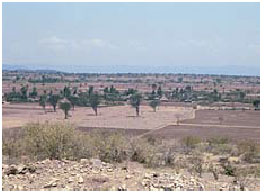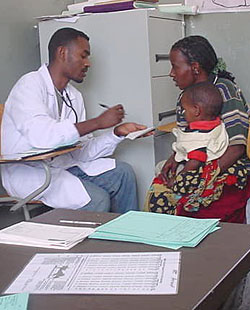Poor rains bring harsh and widespread damage that reaches beyond simple water shortages. The downstream consequences from crop and livestock failure create a dangerous spiral: Hunger and malnutrition lead to increased rates of infectious disease that drain resources and suppress productivity, which, in turn, leads to further food shortages and hunger.
 At the same time, lack of water limits the use of sanitation and hygiene practices, and the few water sources that do exist become centers of overcrowding and contamination as well as reservoirs for disease. he combination of malnutrition, overcrowding, and contamination can destroy a community.
At the same time, lack of water limits the use of sanitation and hygiene practices, and the few water sources that do exist become centers of overcrowding and contamination as well as reservoirs for disease. he combination of malnutrition, overcrowding, and contamination can destroy a community.
Carter Center Photos
Managing health in disaster situations requires specialized interventions and, thus, explicit training. In response the 2002-2003 drought, the Ethiopia Public Health Training Initiative began a project to combat the frequent drought-related health and nutrition problems. The initiative was in a unique position to provide assistance to the affected communities because of its established training model wdithin the colleges and universities. Ethiopian faculty and students were the impetus for the drought response project, a testament to the personal and community empowerment fostered by the initiative.
Every health student is required to complete a practical field training component in his or her senior year. Usually these assignments are in nearby communities and in conjunction with a university-related health center. In response to the drought, 2,191 students were deployed instead to drought-affected communities to fulfill their practical experience. In a remarkable display of dedication and compassion, many of these students stayed on past their required time commitment to continue providing these essential services.
Staff and students deployed by institution, region, and population benefitted
University
Deployment Region
Staff Deployed
Students Deployed
Population Benefitted
Alemeya Oromiya and Somali ---** 517 2,736,987 Debub SNNPR*** -- 775 4,155,633 Gondar Amhara -- 413 1,777,812 Jimma Oromiya -- 169 1,565,742 Addis Ababa Oromiya and Afar -- 317 450,430 Total --- 350 2,191 10,086,604
At the completion of this field intervention, it was determined that because droughts are a recurring problem for this region, preparation and training are needed to prevent and manage future droughts. The Ethiopia Public Health Initiative agreed to build on the existing university partnerships to develop and integrate drought response training into the curriculum.
Major topics of focus include:
Nutritional/Therapeutic Feeding
With the severe crop and livestock shortages, quality becomes as important as quantity. If limited foodstuffs are available, it is crucial that the most nutritional and beneficial foods are consumed. Therapeutic feeding is often for the severely undernourished, usually children.
Epidemic Control and Preparation
The most common disease outbreak associated with the drought in Ethiopia was malaria. Under Trained 2,000 health workers nourished children are the most at risk for contracting malaria, although during a drought adult cases are also more frequent. In addition, diarrhea rates dramatically increase, as it most often is caused by the spread of bacteria and parasites through contaminated water supplies. Controlling an epidemic involves unique strategies not normally utilized in basic health care services
 Maternal and Child Health
Maternal and Child Health
Mothers and children are the most severely affected by droughts because they are often already malnourished or have compromised health. Specific interventions, such as immunization, therapeutic nutrition feedings, and malaria prevention, need implementing to improve the health of these vulnerable populations.
Immunization Programs
The droughts in Ethiopia often occur in regions with particularly poor health indicators and extremely limited health services. Improving basic health services, such as increasing immunization rates, especially measles immunizations, in nondrought years, will go a long way to reducing the levels of disease and death during future droughts.
Summary of preventive activities by training institution
Activities Universities* Total Alemeya Debub Gondar Jimma
Addis
Ababa
Number of Latrines Constructed 157 243 12 6 10 428 Number of Water Sources Constructed 32 20 16 1 2 71 Number of Waste Disposal Pits Dug 50 467 44 28 5 594 People Who Received Health Education 50,993 218,550 24,760 44,904 35,342 374,549 People Trained in First Aid 1,127 668 377 94 -- 2,266 Number of Sanitation Campaigns Conducted 5 33 -- -- -- 38
Please sign up below for important news about the work of The Carter Center and special event invitations.
University Partners
Learn more about the location and
work of EPHTI's university partners.
(Note: Scroll mouse over city name; information will appear at bottom.)
2002-2003 Drought
This drought affected 14 million Ethiopians.
The hardest hit areas were in eastern Ethiopia.
74 percent of Ethiopia's population, or 50 million people, depend on agriculture for their livelihood.
Agriculture constitutes half of Ethiopia's gross domestic product.
*EPHTI's Final Drought Response Report: 2004
Projects accomplished during field training:
Served attachment area of about 10 million people.
Constructed 428 latrines.
Built 71 water points.
Dug 600 waste pits.
Delivered health education to 400,00 people
Saw 3,200 children for therapeutic feeding